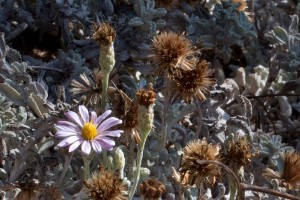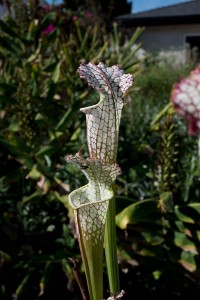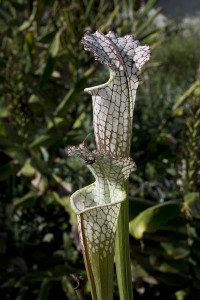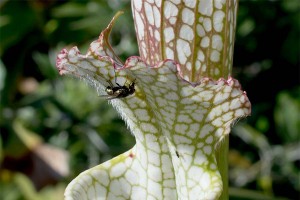Is a camera with more megapixels better? In our bigger is better culture your might be inclined to think so, but for everyday use more could be serious overkill. Here’s a quick look at some of what a super-high resolution camera can do with subject matter in the early autumn garden.
One of the main reasons for a pile of megapixels is for making large prints. My background in large-format film cameras got me used to being able to produce 20 x 24 inch prints that you could look at with a magnifying glass to see even more detail. That’s not a requirement for most photographers.
Here’s a shot of Corethrogyne (a.k.a. Lessingia) filaginifolia next to some stepping stones in the garden. Flowers this time of year are pretty thin, and this is one of the great plants that comes to the rescue by blooming in late summer and fall.
This is a full-pixel crop of the above. (Click to enlarge to 600 x 900 on your screen.) The dried flowers are pretty sharp, still. The open flower is a little blurry, but that’s more from being a little out of focus. It’s not great art, but if you were to print the first image full frame, the extra resolution would let you make prints with nice detail.
Related to the issue of making larger prints, images with higher megapixels allow you to make nicer looking cropped versions. You might want to crop an image for prints, or you might just want to be able to show closeups from a larger image for use on the web.
Sarracenia leucophylla “Super Swamp Ghost,” putting out some new pitchers for the fall. This is the original full-frame image. The picture has stuff on the margins that I thought was pretty distracting.
This is a slight crop of the previous, making a cleaner illustration with fewer distractions. You’d be able to do this with most images from most cameras.
But what if you decided to crop to isolate just the mouth of one of the pitchers? I saw the one large fly when I took the photo, but I didn’t see the smaller one to the right until I looked closer.
Or how about getting really close, to take a really good look at the bigger fly? Or how about wanting to take a look at the hairs on the interior of the pitcher that direct insects downward, into the tube, into the digestive juices, never to escape. This is where the higher resolution original image gives you more options.
Why yes, you’d be able to accomplish some of this with a good zoom lens on your camera. But if you wanted to extend the reach of your zoom, it helps to have a photo with more information in it. Also zoom lenses don’t generally give you same image quality as lenses of fixed focal length, so that a $150 fixed lens can give results that would dust a premium zoom more than ten times the price.
The rest of these images are just quick looks at other things in the garden, not necessarily anything you’d want to print at a large size. I’ve down-sized the images from 7360 x 4912 pixels to 900 x 600, and this blog page further reduces them to 300 x 200. (Click to see the intermediate size.) If you only need photos this size, there’s probably no real need for a high megapixel camera.
Another of the pitcher plants, Sarracenia Sky Watcher.
Sarracenia leucophylla, “Hot Pink” clone from Botanique.
Sarracenia Green Monster x xcourtii, a cross by Rob Co of The Pitcher Plant Project.
Sarracenia alata x minor with a garden frog, contemplating the universe, deciding if it needs a high megapixel camera.
Dried flower heads, late season, on black sage. Salvia mellifera.
A sure sign that autumn is here, the dried flower heads and supporting stems from San Miguel Island buckwheat, Eriogonum grande var. rubescens. If you water the plant more than I do it’d stay a little greener. This plant is anything but dead, with there still being lots of green closer to the crown of the plant. Some people would cut all this back, but I really like how it looks draped over this patinated wall.
Cropped and focused a little differently and photographed with a little more care than my quick snapshot this might make a nice wall print.
FYI, the camera used here was the Nikon D800E, which is categorized at 36.3 megapixels. That’s pretty extreme for a small DSLR. But if you want to talk about extremem miniaturization, there’s even a 41 megapixel cellphone camera, the Nokia PureView 808. Word on the street is that it’s not a particularly great picture-take much higher than when you set it at at 5 megapixels, within the range many cellphone cameras operate in. Making a 41 megapixel cellphone camera seems to be a mostly a stunt, technically an extremely high-res camera, but almsot useless when operated that way. The Nikon by contrast is actually a good camera.













dear james, thank you for a timely useful lesson. I am on a steep learning curve photography-wise and this post provided me with a definite boost. Particularly about the link between wanting to crop and higher pixels. I took the trouble to click on your photos to enlarge them and it was worth it. Pitcher plants are fascinating as well as magnificent to look at. I saw a heading recently that pollution is causing carnivorous plants to become vegetarian. Have you heard about this? cheers, catmint
Catmint, I remember some discussion on the carnivorous plant discussion boards about the vegetarian carnivore question…something about how nitrogen in the air was getting fixed when it rains, allowing the plants to soak up nutrition from the water and soil instead of needing to get it from insect prey. Long-term it sounds bad for the evolution of these amazing plants. Short-term I wonder about the plants’ health. I know that one of the worst things you can do is to give these plants much food. Even with the California native plants I showed in addition to the carnivores, they frequently do better without plant food, just getting what they need from the soils so that they don’t grow too succulent and start attracting ordinary garden pests.
I am deeply suspicious about ‘plant food’ sold in nurseries. Composted materials and appropriate soil provide plants with food. I cynically assume ‘plant food’ mainly benefits those in the horticultural industry.
Hmm. I don’t know nothin about cameras but I do know you’ve taken some mighty fine pictures with that bit of camera tech.
My favourite part of taking photos, is cutting them down to size on the computer. I’m often amazed by how much detail lends itself to placing in the spotlight.
Catmint, I will use plant food on potted plants, but I figure that they’re under distress and need more support to keep them nourished. But for plants in the ground…I might give my tomatoes some food, but I don’t fertilize most of the rest of the garden.
Faisal, thank you! I love excuses to go into the garden.
Diana, I love how cameras work so well as a spare pair of eyes with a brain attached to remember things, letting us see things we missed the first time around.
This is so useful to me, and I thank you for sharing your insights! I really need to bump up my equipment from my hand-held Costco-special Olympus! You prove the purpose and that there’s no need to have mega-mega pixels for the sake of them alone.
Glad fall is there, even if it’s SD’s summery fall! Ours’ is flowery and/or bad winds. Just had many Salvia greggii blooms desiccated into submission by the latter…fall.
This is helpful. I have a low end Cannon Rebel with a kit zoom lens and I’ve been extraordinarily disappointed with the resolution (it’s 10 or 12 megapixels, but I think that’s not the problem). From what you write, I think my lens is the problem. I think I’ll try fixed focal length (nonzoom) lens and see what I get. Even using the full image, I get very poor resolution. I’ve also read the Canon image sensor is smaller than many comparable cameras.
Most of us could use a little camera coaching.Thanks! And your pitcher pix are amazing.
David, I’ve tried to do bodies of work with some of the most pedestrian equipment like a cellphone camera, but there’s just so much you can do with making work about limitations and what the camera can’t do. Match your photographic tool to the task and you’re much of the way there.
James, most of the recent non-cellphone camera photos on my blog have come out of a Rebel. Given reasonable optics and a steady hand the Rebel can produce excellent results for most online uses. Canon’s sensor is a smidge smaller than Nikon’s for that class of camera, but I think the difference is negligible, particularly when compare to the “full-frame” cameras that have sensors the size of a 35mm frame. The latter are much pricier, and really unnecessary for making images up to 11×14 or so if you don’t crop much.
Ricki, thank you! The pitcher plants are so photogenic that it’s hard to make a bad photo of them.
That’s a really good post debunking the mystery surrounding megapixels. A 41 megapixel cellphone camera?! Now that’s just madness!
Lovely photos of your Sarracenias. Much as I love the markings on the others, my favourite is the Green Monster – looks rather muppet-like, somehow. As to cutting back the Eriogonum, that would be criminal, it looks beautiful against that wall.